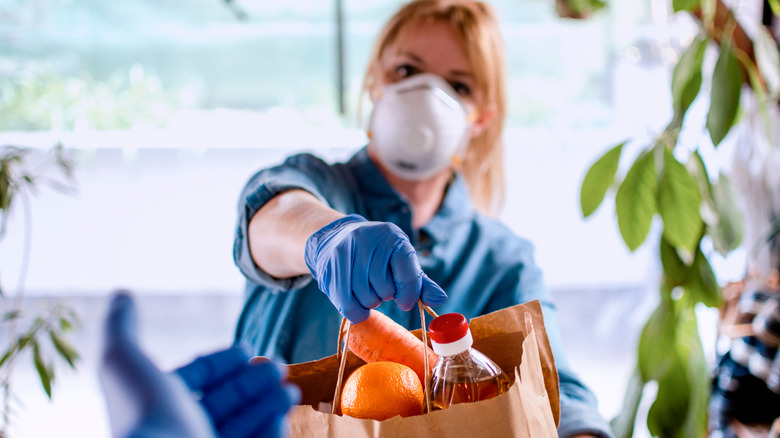Is It Safe To Eat Food Handled With Latex Gloves If You're Allergic To Latex?
When you're allergic to something, you probably try to avoid that allergen, but it can be difficult to know all of the places an allergen may be lurking. Latex is one allergen that can be found in places that might surprise you. When someone has a latex allergy, their immune system has an exaggerated and sometimes very intense reaction to some of the proteins found in latex, says WebMD. It's believed that continuous contact with latex can lead to the development of an allergy. In fact, up to 10% of healthcare workers who regularly wear latex gloves develop an allergy, as do many people who use latex condoms. So even if you don't have a latex allergy now, being aware of how often you expose yourself to it may be helpful, should you develop an allergy in the future.
Natural rubber latex is a plant-derived material created from the sap of various plants mostly found in Latin and South American countries (per U.S. Forest Service). Fun fact, explorers Hernan Cortez and Christopher Columbus discovered latex in Mexico and the Caribbean, respectively. Today, latex is used as a bonding agent in a plethora of products, including mattresses, paint, cosmetic products, and clothing. Allergic reactions to latex can occur after physical contact with latex items, like balloons and gloves (via Mayo Clinic). Keep in mind, this allergen can still reach you through particles in the air after another person removes latex gloves or latex is used in the handling of products.
The danger of latex particles
Latex particles are one way that this allergen can unknowingly reach someone with a latex allergy (per Mayo Clinic). A 2008 study published in the Journal of Food Protection found that latex proteins from the use of latex gloves by food handlers can contaminate items and cause consumers with latex allergies to have allergic reactions. Researchers determined that repeated, prolonged exposure to products containing latex can create a predisposition for a latex allergy. Especially for people who are atopic, meaning that they are prone to allergies. Recurrent exposure to latex includes the absorption of particles. The findings of the study led researchers to advocate for the replacement of latex gloves in the food processing industry with non-latex gloves.
Not only can allergy-causing proteins be passed through latex particles in the air and through consumption of food handled with latex gloves, but there are several foods that contain similar proteins to latex and can cause what is called a cross-reaction (via New York State Department of Health). If you are allergic to latex, then you may be at risk of having a cross-reaction to foods, including rye, wheat, chestnuts, hazelnuts, celery, raw potatoes, and carrots. There are many fruits that can also cause cross-reactions, like grapes, cherries, pineapple, avocados, bananas, strawberries, apples, tomatoes, kiwi, pears, plums, papaya, nectarines, peaches, passion fruit, and figs.
How to keep food latex-free
If you have a latex allergy, there are several things you can do to keep yourself and your food safe. The Asthma and Allergy Foundation of America (AAFA) recommends avoiding cross-reactive foods. Allergic reactions to this are known as Latex-Fruit Allergy or Latex-Food Syndrome. Nevertheless, it's always best to speak with your doctor about which foods are safe to eat if you have a known latex allergy. You'll want to refrain from consuming food that has had contact with other latex-containing items, like rubber bands, glues, and adhesives used to seal containers (via WebMD). Be mindful of the items used to prepare food, like rubber gloves and sink mats that may come into contact with serving dishes and utensils. Avoid utensils made of rubber and those with rubber grips. When choosing food storage products, look for items that specifically state they're latex-free (per MIC).
The AAFA recommends knowing the signs of a latex allergic reaction, and if you have a known allergy to latex, learning how to administer self-inject epinephrine in the event of a severe reaction. According to Mayo Clinic, mild-to-moderate symptoms of a latex allergic reaction include itchiness, sneezing, runny nose, redness of the skin, and a scratchy throat. Latex allergy can present a life-threatening condition called anaphylaxis, for which signs are trouble breathing, vomiting, dizziness, sudden drop in blood pressure, and loss of consciousness. If someone has signs of anaphylaxis, immediate emergency medical care should be sought.



